Analysis of GSK: Organizational Behavior, Leadership, and Structure
VerifiedAdded on 2020/01/23
|18
|5115
|110
Report
AI Summary
This report delves into the organizational structure, leadership styles, and cultural aspects of GlaxoSmithKline (GSK). It compares and contrasts GSK's structure and culture with other organizations, exploring the impact on performance. The report examines how individual employee behavior is influenced by various factors within GSK, including demographic, environmental, psychological, and personal aspects. Different leadership styles, such as autocratic and participative, are evaluated, alongside the application of organizational theories like contingency theory to management practices. Furthermore, the report analyzes motivational theories and their impact during periods of change, comparing different approaches and assessing their usefulness. The analysis extends to group behavior, the factors affecting effective teamwork, and the influence of technology on team functioning at GSK. The report also includes a comparison of management approaches at GSK and a similar organization, Amgen, evaluating scientific management theory, administrative theory, and critical path analysis. The findings highlight the importance of leadership in shaping organizational culture and the effective use of motivational strategies.
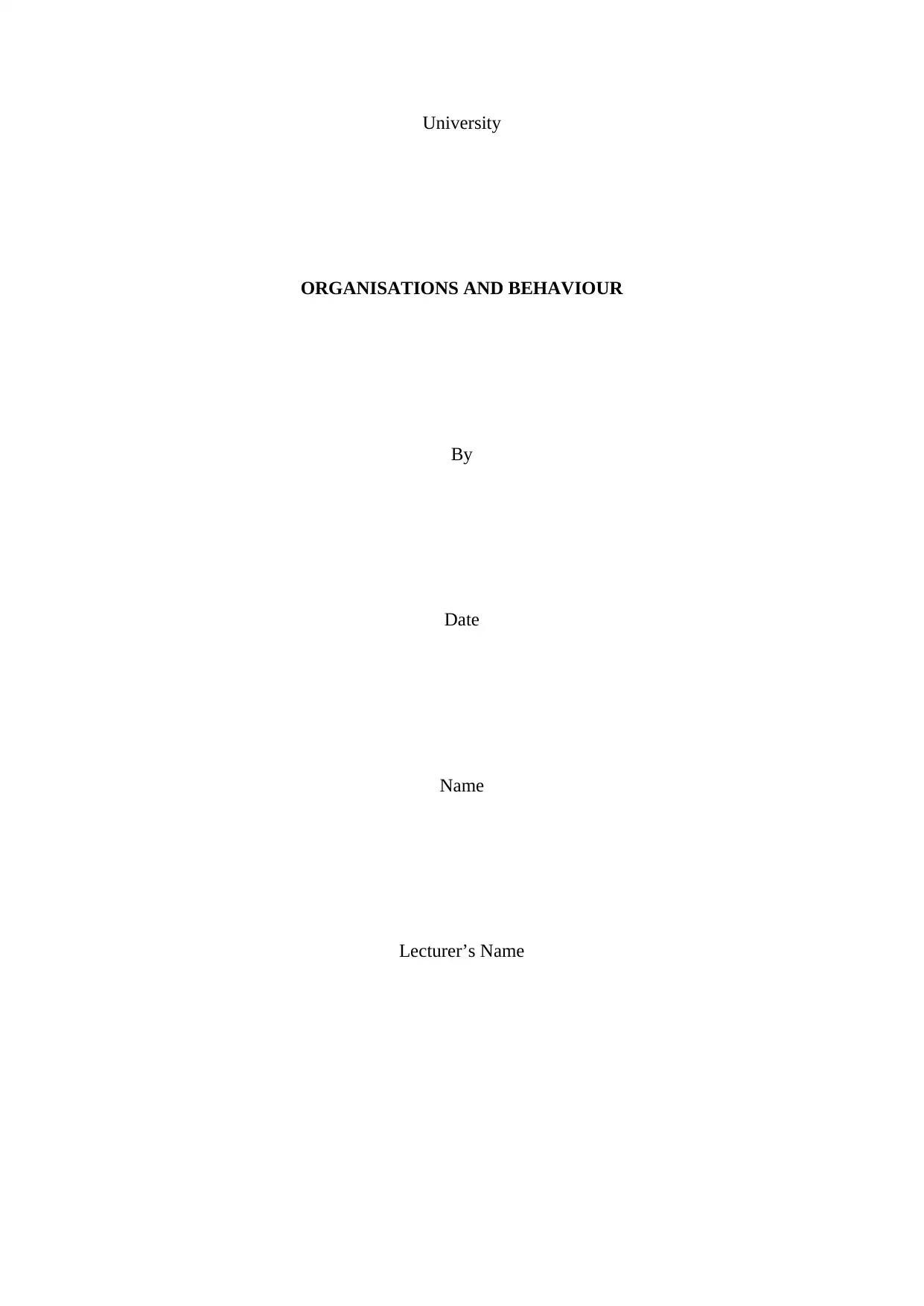
University
ORGANISATIONS AND BEHAVIOUR
By
Date
Name
Lecturer’s Name
ORGANISATIONS AND BEHAVIOUR
By
Date
Name
Lecturer’s Name
Paraphrase This Document
Need a fresh take? Get an instant paraphrase of this document with our AI Paraphraser
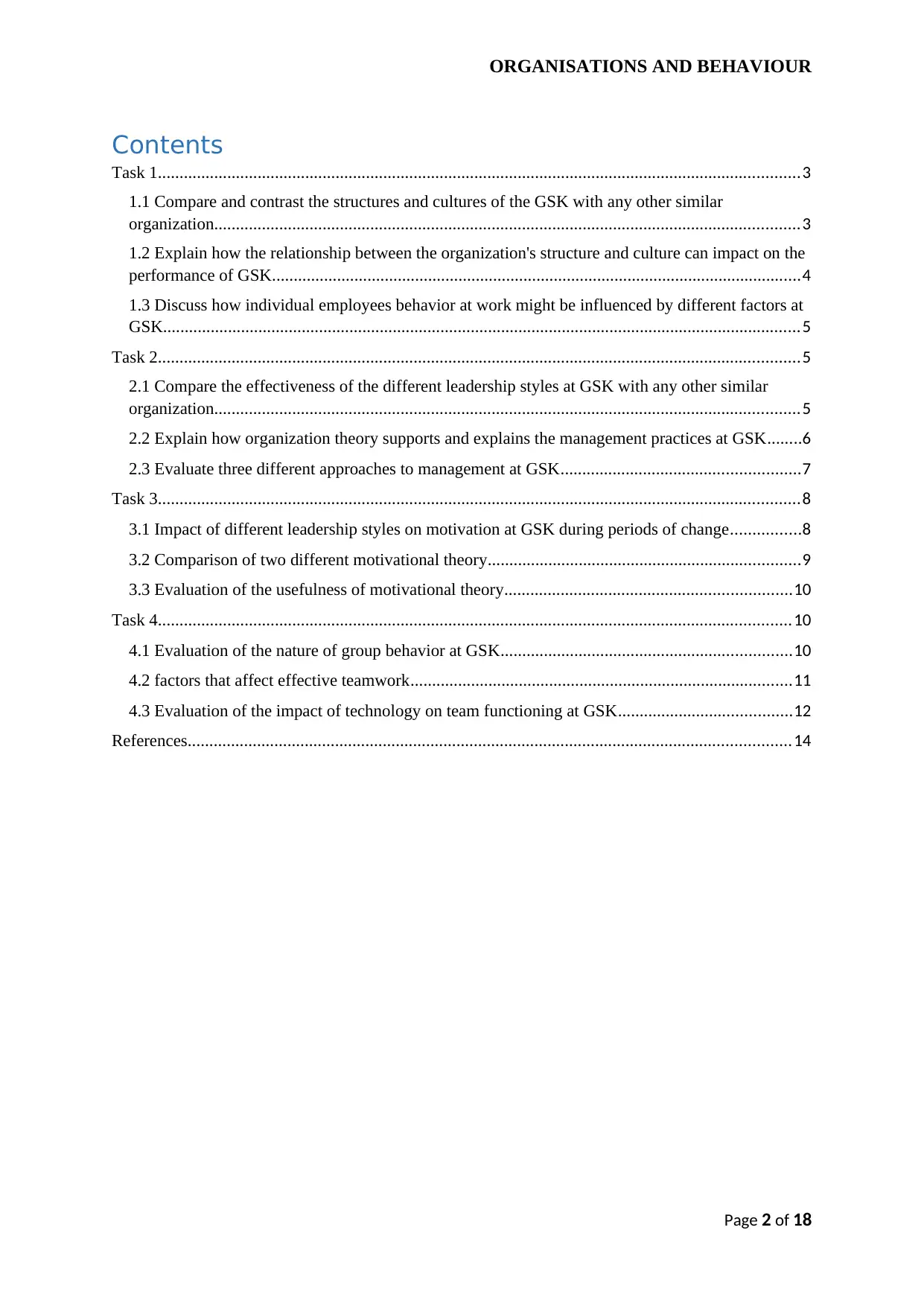
ORGANISATIONS AND BEHAVIOUR
Contents
Task 1....................................................................................................................................................3
1.1 Compare and contrast the structures and cultures of the GSK with any other similar
organization.......................................................................................................................................3
1.2 Explain how the relationship between the organization's structure and culture can impact on the
performance of GSK..........................................................................................................................4
1.3 Discuss how individual employees behavior at work might be influenced by different factors at
GSK...................................................................................................................................................5
Task 2....................................................................................................................................................5
2.1 Compare the effectiveness of the different leadership styles at GSK with any other similar
organization.......................................................................................................................................5
2.2 Explain how organization theory supports and explains the management practices at GSK........6
2.3 Evaluate three different approaches to management at GSK.......................................................7
Task 3....................................................................................................................................................8
3.1 Impact of different leadership styles on motivation at GSK during periods of change................8
3.2 Comparison of two different motivational theory........................................................................9
3.3 Evaluation of the usefulness of motivational theory..................................................................10
Task 4..................................................................................................................................................10
4.1 Evaluation of the nature of group behavior at GSK...................................................................10
4.2 factors that affect effective teamwork........................................................................................11
4.3 Evaluation of the impact of technology on team functioning at GSK........................................12
References...........................................................................................................................................14
Page 2 of 18
Contents
Task 1....................................................................................................................................................3
1.1 Compare and contrast the structures and cultures of the GSK with any other similar
organization.......................................................................................................................................3
1.2 Explain how the relationship between the organization's structure and culture can impact on the
performance of GSK..........................................................................................................................4
1.3 Discuss how individual employees behavior at work might be influenced by different factors at
GSK...................................................................................................................................................5
Task 2....................................................................................................................................................5
2.1 Compare the effectiveness of the different leadership styles at GSK with any other similar
organization.......................................................................................................................................5
2.2 Explain how organization theory supports and explains the management practices at GSK........6
2.3 Evaluate three different approaches to management at GSK.......................................................7
Task 3....................................................................................................................................................8
3.1 Impact of different leadership styles on motivation at GSK during periods of change................8
3.2 Comparison of two different motivational theory........................................................................9
3.3 Evaluation of the usefulness of motivational theory..................................................................10
Task 4..................................................................................................................................................10
4.1 Evaluation of the nature of group behavior at GSK...................................................................10
4.2 factors that affect effective teamwork........................................................................................11
4.3 Evaluation of the impact of technology on team functioning at GSK........................................12
References...........................................................................................................................................14
Page 2 of 18
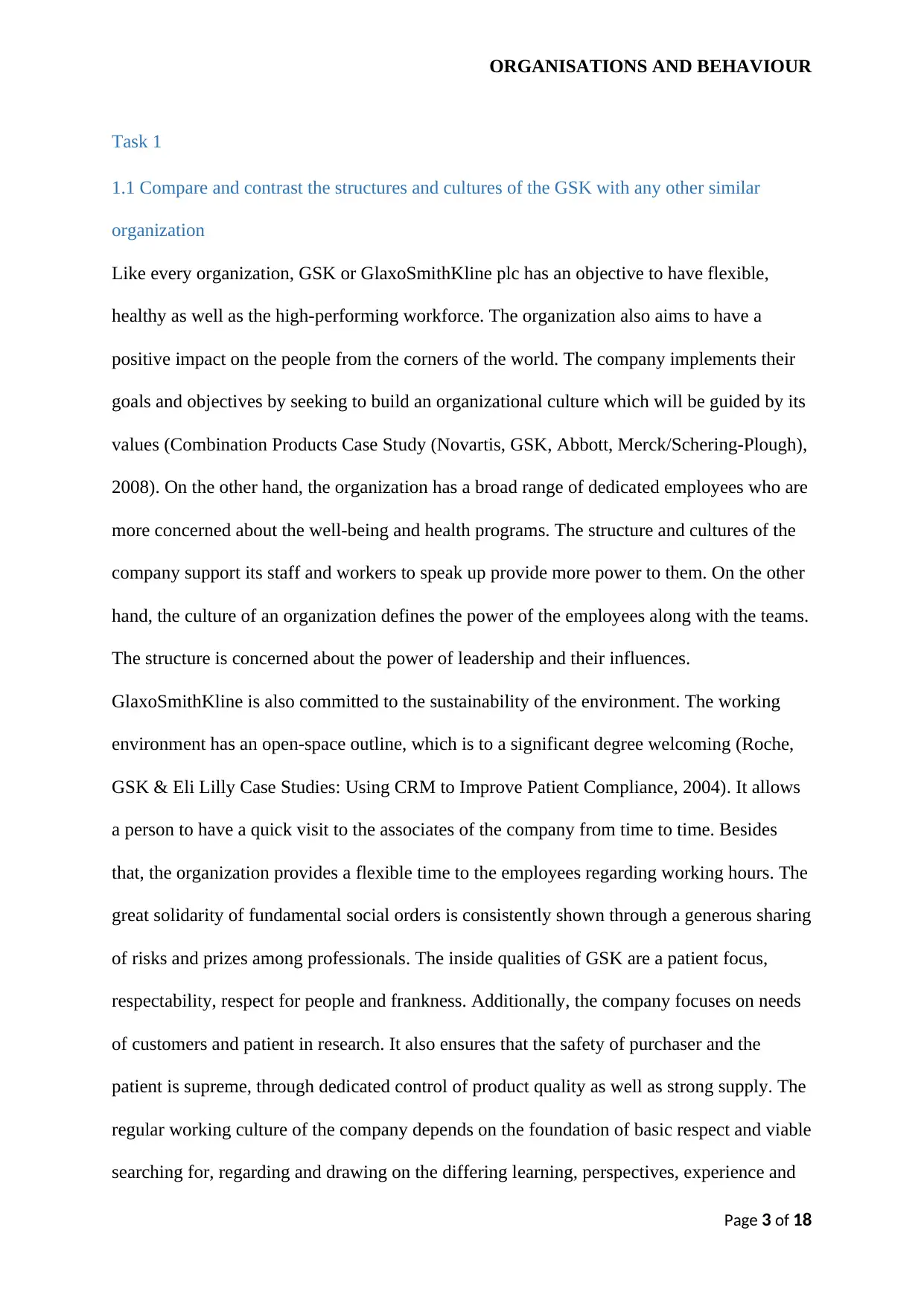
ORGANISATIONS AND BEHAVIOUR
Task 1
1.1 Compare and contrast the structures and cultures of the GSK with any other similar
organization
Like every organization, GSK or GlaxoSmithKline plc has an objective to have flexible,
healthy as well as the high-performing workforce. The organization also aims to have a
positive impact on the people from the corners of the world. The company implements their
goals and objectives by seeking to build an organizational culture which will be guided by its
values (Combination Products Case Study (Novartis, GSK, Abbott, Merck/Schering-Plough),
2008). On the other hand, the organization has a broad range of dedicated employees who are
more concerned about the well-being and health programs. The structure and cultures of the
company support its staff and workers to speak up provide more power to them. On the other
hand, the culture of an organization defines the power of the employees along with the teams.
The structure is concerned about the power of leadership and their influences.
GlaxoSmithKline is also committed to the sustainability of the environment. The working
environment has an open-space outline, which is to a significant degree welcoming (Roche,
GSK & Eli Lilly Case Studies: Using CRM to Improve Patient Compliance, 2004). It allows
a person to have a quick visit to the associates of the company from time to time. Besides
that, the organization provides a flexible time to the employees regarding working hours. The
great solidarity of fundamental social orders is consistently shown through a generous sharing
of risks and prizes among professionals. The inside qualities of GSK are a patient focus,
respectability, respect for people and frankness. Additionally, the company focuses on needs
of customers and patient in research. It also ensures that the safety of purchaser and the
patient is supreme, through dedicated control of product quality as well as strong supply. The
regular working culture of the company depends on the foundation of basic respect and viable
searching for, regarding and drawing on the differing learning, perspectives, experience and
Page 3 of 18
Task 1
1.1 Compare and contrast the structures and cultures of the GSK with any other similar
organization
Like every organization, GSK or GlaxoSmithKline plc has an objective to have flexible,
healthy as well as the high-performing workforce. The organization also aims to have a
positive impact on the people from the corners of the world. The company implements their
goals and objectives by seeking to build an organizational culture which will be guided by its
values (Combination Products Case Study (Novartis, GSK, Abbott, Merck/Schering-Plough),
2008). On the other hand, the organization has a broad range of dedicated employees who are
more concerned about the well-being and health programs. The structure and cultures of the
company support its staff and workers to speak up provide more power to them. On the other
hand, the culture of an organization defines the power of the employees along with the teams.
The structure is concerned about the power of leadership and their influences.
GlaxoSmithKline is also committed to the sustainability of the environment. The working
environment has an open-space outline, which is to a significant degree welcoming (Roche,
GSK & Eli Lilly Case Studies: Using CRM to Improve Patient Compliance, 2004). It allows
a person to have a quick visit to the associates of the company from time to time. Besides
that, the organization provides a flexible time to the employees regarding working hours. The
great solidarity of fundamental social orders is consistently shown through a generous sharing
of risks and prizes among professionals. The inside qualities of GSK are a patient focus,
respectability, respect for people and frankness. Additionally, the company focuses on needs
of customers and patient in research. It also ensures that the safety of purchaser and the
patient is supreme, through dedicated control of product quality as well as strong supply. The
regular working culture of the company depends on the foundation of basic respect and viable
searching for, regarding and drawing on the differing learning, perspectives, experience and
Page 3 of 18
⊘ This is a preview!⊘
Do you want full access?
Subscribe today to unlock all pages.

Trusted by 1+ million students worldwide
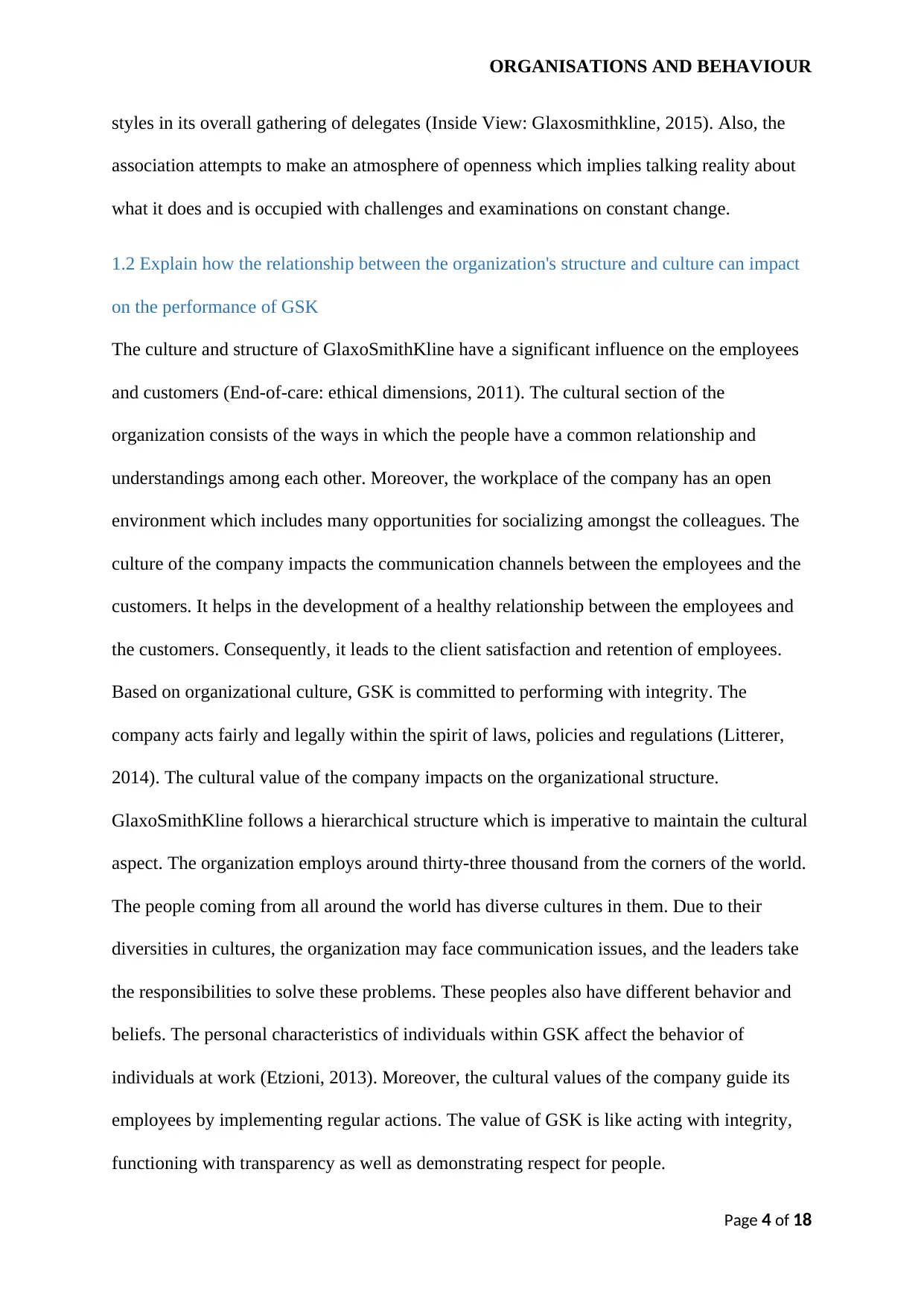
ORGANISATIONS AND BEHAVIOUR
styles in its overall gathering of delegates (Inside View: Glaxosmithkline, 2015). Also, the
association attempts to make an atmosphere of openness which implies talking reality about
what it does and is occupied with challenges and examinations on constant change.
1.2 Explain how the relationship between the organization's structure and culture can impact
on the performance of GSK
The culture and structure of GlaxoSmithKline have a significant influence on the employees
and customers (End-of-care: ethical dimensions, 2011). The cultural section of the
organization consists of the ways in which the people have a common relationship and
understandings among each other. Moreover, the workplace of the company has an open
environment which includes many opportunities for socializing amongst the colleagues. The
culture of the company impacts the communication channels between the employees and the
customers. It helps in the development of a healthy relationship between the employees and
the customers. Consequently, it leads to the client satisfaction and retention of employees.
Based on organizational culture, GSK is committed to performing with integrity. The
company acts fairly and legally within the spirit of laws, policies and regulations (Litterer,
2014). The cultural value of the company impacts on the organizational structure.
GlaxoSmithKline follows a hierarchical structure which is imperative to maintain the cultural
aspect. The organization employs around thirty-three thousand from the corners of the world.
The people coming from all around the world has diverse cultures in them. Due to their
diversities in cultures, the organization may face communication issues, and the leaders take
the responsibilities to solve these problems. These peoples also have different behavior and
beliefs. The personal characteristics of individuals within GSK affect the behavior of
individuals at work (Etzioni, 2013). Moreover, the cultural values of the company guide its
employees by implementing regular actions. The value of GSK is like acting with integrity,
functioning with transparency as well as demonstrating respect for people.
Page 4 of 18
styles in its overall gathering of delegates (Inside View: Glaxosmithkline, 2015). Also, the
association attempts to make an atmosphere of openness which implies talking reality about
what it does and is occupied with challenges and examinations on constant change.
1.2 Explain how the relationship between the organization's structure and culture can impact
on the performance of GSK
The culture and structure of GlaxoSmithKline have a significant influence on the employees
and customers (End-of-care: ethical dimensions, 2011). The cultural section of the
organization consists of the ways in which the people have a common relationship and
understandings among each other. Moreover, the workplace of the company has an open
environment which includes many opportunities for socializing amongst the colleagues. The
culture of the company impacts the communication channels between the employees and the
customers. It helps in the development of a healthy relationship between the employees and
the customers. Consequently, it leads to the client satisfaction and retention of employees.
Based on organizational culture, GSK is committed to performing with integrity. The
company acts fairly and legally within the spirit of laws, policies and regulations (Litterer,
2014). The cultural value of the company impacts on the organizational structure.
GlaxoSmithKline follows a hierarchical structure which is imperative to maintain the cultural
aspect. The organization employs around thirty-three thousand from the corners of the world.
The people coming from all around the world has diverse cultures in them. Due to their
diversities in cultures, the organization may face communication issues, and the leaders take
the responsibilities to solve these problems. These peoples also have different behavior and
beliefs. The personal characteristics of individuals within GSK affect the behavior of
individuals at work (Etzioni, 2013). Moreover, the cultural values of the company guide its
employees by implementing regular actions. The value of GSK is like acting with integrity,
functioning with transparency as well as demonstrating respect for people.
Page 4 of 18
Paraphrase This Document
Need a fresh take? Get an instant paraphrase of this document with our AI Paraphraser
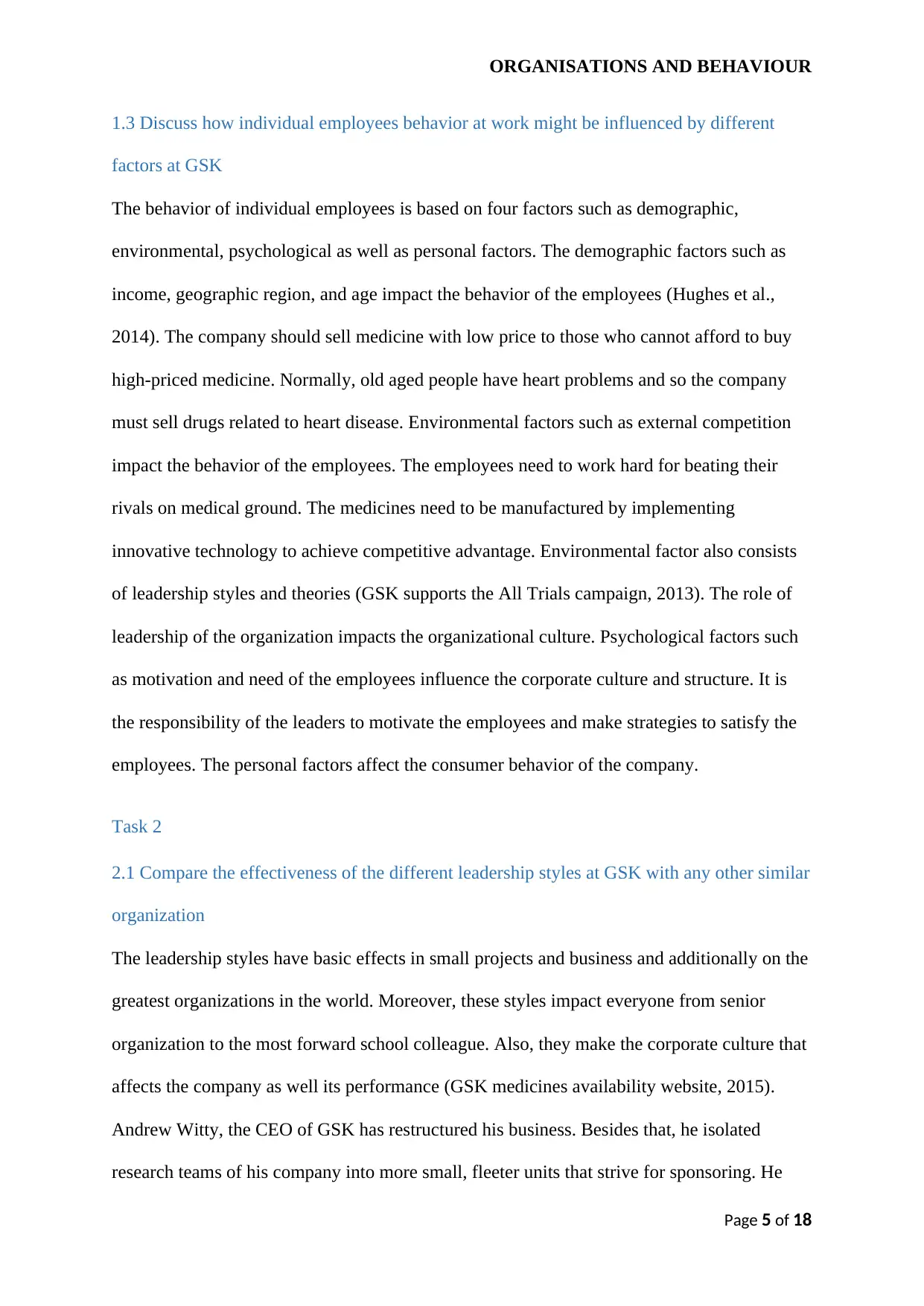
ORGANISATIONS AND BEHAVIOUR
1.3 Discuss how individual employees behavior at work might be influenced by different
factors at GSK
The behavior of individual employees is based on four factors such as demographic,
environmental, psychological as well as personal factors. The demographic factors such as
income, geographic region, and age impact the behavior of the employees (Hughes et al.,
2014). The company should sell medicine with low price to those who cannot afford to buy
high-priced medicine. Normally, old aged people have heart problems and so the company
must sell drugs related to heart disease. Environmental factors such as external competition
impact the behavior of the employees. The employees need to work hard for beating their
rivals on medical ground. The medicines need to be manufactured by implementing
innovative technology to achieve competitive advantage. Environmental factor also consists
of leadership styles and theories (GSK supports the All Trials campaign, 2013). The role of
leadership of the organization impacts the organizational culture. Psychological factors such
as motivation and need of the employees influence the corporate culture and structure. It is
the responsibility of the leaders to motivate the employees and make strategies to satisfy the
employees. The personal factors affect the consumer behavior of the company.
Task 2
2.1 Compare the effectiveness of the different leadership styles at GSK with any other similar
organization
The leadership styles have basic effects in small projects and business and additionally on the
greatest organizations in the world. Moreover, these styles impact everyone from senior
organization to the most forward school colleague. Also, they make the corporate culture that
affects the company as well its performance (GSK medicines availability website, 2015).
Andrew Witty, the CEO of GSK has restructured his business. Besides that, he isolated
research teams of his company into more small, fleeter units that strive for sponsoring. He
Page 5 of 18
1.3 Discuss how individual employees behavior at work might be influenced by different
factors at GSK
The behavior of individual employees is based on four factors such as demographic,
environmental, psychological as well as personal factors. The demographic factors such as
income, geographic region, and age impact the behavior of the employees (Hughes et al.,
2014). The company should sell medicine with low price to those who cannot afford to buy
high-priced medicine. Normally, old aged people have heart problems and so the company
must sell drugs related to heart disease. Environmental factors such as external competition
impact the behavior of the employees. The employees need to work hard for beating their
rivals on medical ground. The medicines need to be manufactured by implementing
innovative technology to achieve competitive advantage. Environmental factor also consists
of leadership styles and theories (GSK supports the All Trials campaign, 2013). The role of
leadership of the organization impacts the organizational culture. Psychological factors such
as motivation and need of the employees influence the corporate culture and structure. It is
the responsibility of the leaders to motivate the employees and make strategies to satisfy the
employees. The personal factors affect the consumer behavior of the company.
Task 2
2.1 Compare the effectiveness of the different leadership styles at GSK with any other similar
organization
The leadership styles have basic effects in small projects and business and additionally on the
greatest organizations in the world. Moreover, these styles impact everyone from senior
organization to the most forward school colleague. Also, they make the corporate culture that
affects the company as well its performance (GSK medicines availability website, 2015).
Andrew Witty, the CEO of GSK has restructured his business. Besides that, he isolated
research teams of his company into more small, fleeter units that strive for sponsoring. He
Page 5 of 18
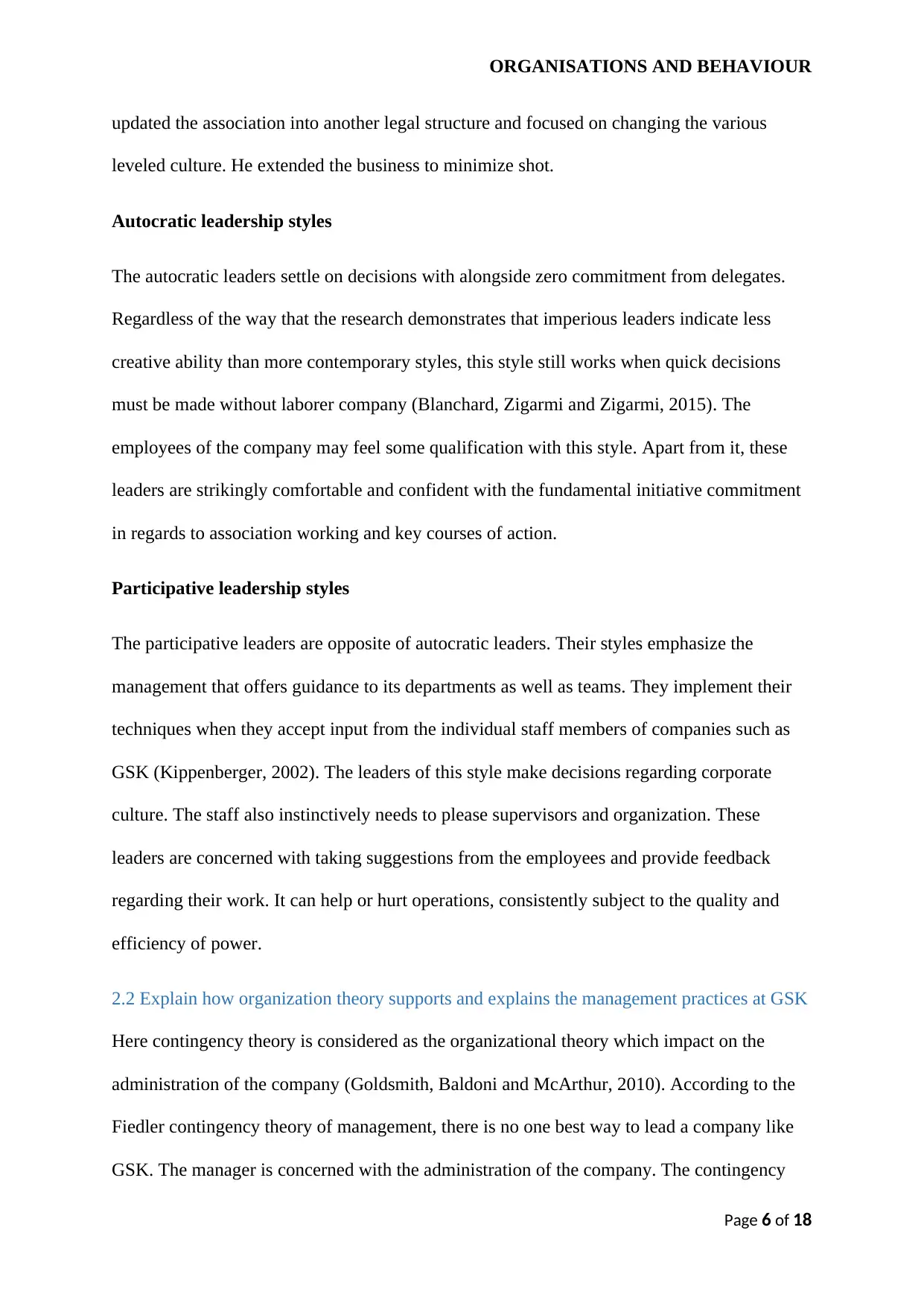
ORGANISATIONS AND BEHAVIOUR
updated the association into another legal structure and focused on changing the various
leveled culture. He extended the business to minimize shot.
Autocratic leadership styles
The autocratic leaders settle on decisions with alongside zero commitment from delegates.
Regardless of the way that the research demonstrates that imperious leaders indicate less
creative ability than more contemporary styles, this style still works when quick decisions
must be made without laborer company (Blanchard, Zigarmi and Zigarmi, 2015). The
employees of the company may feel some qualification with this style. Apart from it, these
leaders are strikingly comfortable and confident with the fundamental initiative commitment
in regards to association working and key courses of action.
Participative leadership styles
The participative leaders are opposite of autocratic leaders. Their styles emphasize the
management that offers guidance to its departments as well as teams. They implement their
techniques when they accept input from the individual staff members of companies such as
GSK (Kippenberger, 2002). The leaders of this style make decisions regarding corporate
culture. The staff also instinctively needs to please supervisors and organization. These
leaders are concerned with taking suggestions from the employees and provide feedback
regarding their work. It can help or hurt operations, consistently subject to the quality and
efficiency of power.
2.2 Explain how organization theory supports and explains the management practices at GSK
Here contingency theory is considered as the organizational theory which impact on the
administration of the company (Goldsmith, Baldoni and McArthur, 2010). According to the
Fiedler contingency theory of management, there is no one best way to lead a company like
GSK. The manager is concerned with the administration of the company. The contingency
Page 6 of 18
updated the association into another legal structure and focused on changing the various
leveled culture. He extended the business to minimize shot.
Autocratic leadership styles
The autocratic leaders settle on decisions with alongside zero commitment from delegates.
Regardless of the way that the research demonstrates that imperious leaders indicate less
creative ability than more contemporary styles, this style still works when quick decisions
must be made without laborer company (Blanchard, Zigarmi and Zigarmi, 2015). The
employees of the company may feel some qualification with this style. Apart from it, these
leaders are strikingly comfortable and confident with the fundamental initiative commitment
in regards to association working and key courses of action.
Participative leadership styles
The participative leaders are opposite of autocratic leaders. Their styles emphasize the
management that offers guidance to its departments as well as teams. They implement their
techniques when they accept input from the individual staff members of companies such as
GSK (Kippenberger, 2002). The leaders of this style make decisions regarding corporate
culture. The staff also instinctively needs to please supervisors and organization. These
leaders are concerned with taking suggestions from the employees and provide feedback
regarding their work. It can help or hurt operations, consistently subject to the quality and
efficiency of power.
2.2 Explain how organization theory supports and explains the management practices at GSK
Here contingency theory is considered as the organizational theory which impact on the
administration of the company (Goldsmith, Baldoni and McArthur, 2010). According to the
Fiedler contingency theory of management, there is no one best way to lead a company like
GSK. The manager is concerned with the administration of the company. The contingency
Page 6 of 18
⊘ This is a preview!⊘
Do you want full access?
Subscribe today to unlock all pages.

Trusted by 1+ million students worldwide
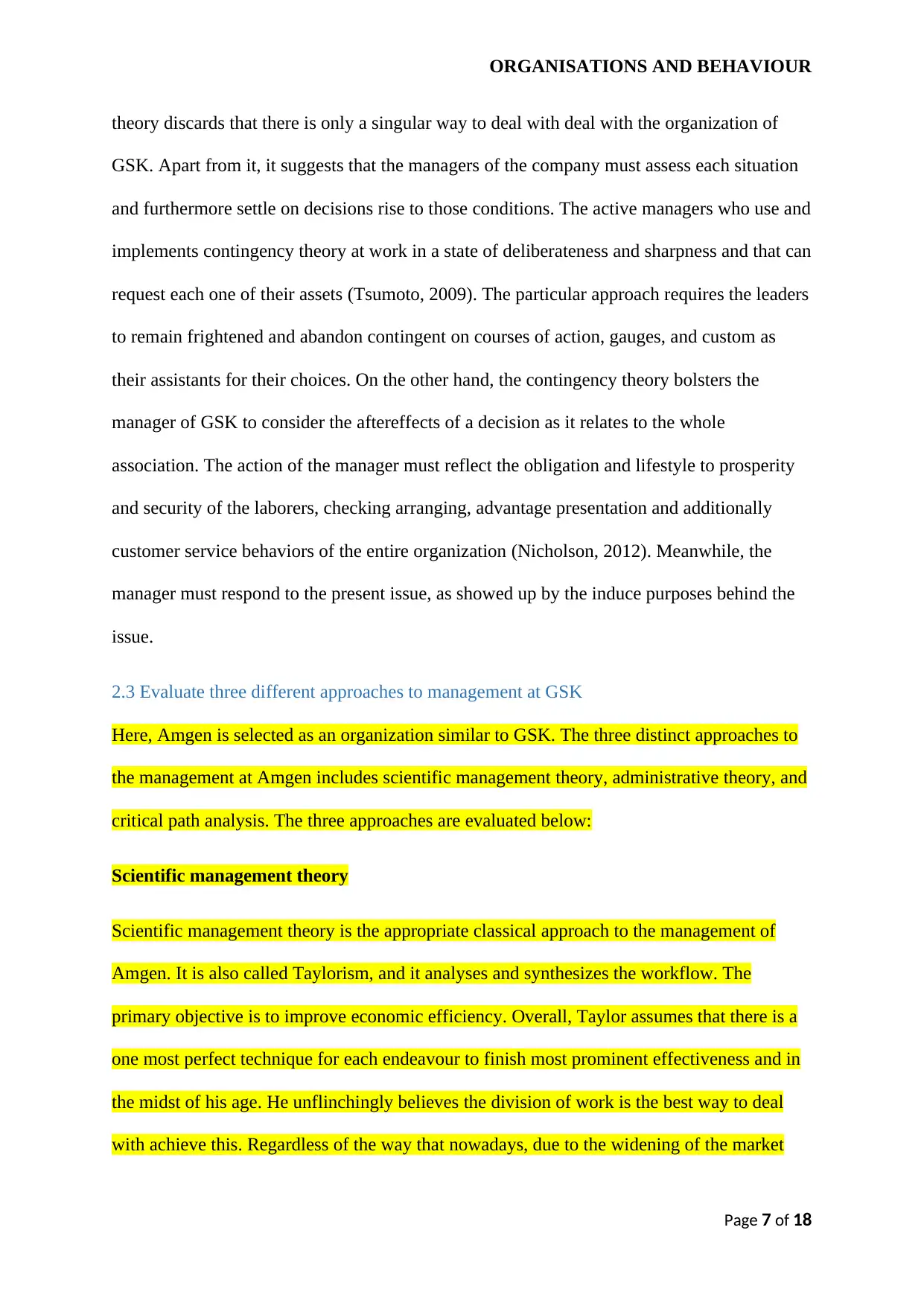
ORGANISATIONS AND BEHAVIOUR
theory discards that there is only a singular way to deal with deal with the organization of
GSK. Apart from it, it suggests that the managers of the company must assess each situation
and furthermore settle on decisions rise to those conditions. The active managers who use and
implements contingency theory at work in a state of deliberateness and sharpness and that can
request each one of their assets (Tsumoto, 2009). The particular approach requires the leaders
to remain frightened and abandon contingent on courses of action, gauges, and custom as
their assistants for their choices. On the other hand, the contingency theory bolsters the
manager of GSK to consider the aftereffects of a decision as it relates to the whole
association. The action of the manager must reflect the obligation and lifestyle to prosperity
and security of the laborers, checking arranging, advantage presentation and additionally
customer service behaviors of the entire organization (Nicholson, 2012). Meanwhile, the
manager must respond to the present issue, as showed up by the induce purposes behind the
issue.
2.3 Evaluate three different approaches to management at GSK
Here, Amgen is selected as an organization similar to GSK. The three distinct approaches to
the management at Amgen includes scientific management theory, administrative theory, and
critical path analysis. The three approaches are evaluated below:
Scientific management theory
Scientific management theory is the appropriate classical approach to the management of
Amgen. It is also called Taylorism, and it analyses and synthesizes the workflow. The
primary objective is to improve economic efficiency. Overall, Taylor assumes that there is a
one most perfect technique for each endeavour to finish most prominent effectiveness and in
the midst of his age. He unflinchingly believes the division of work is the best way to deal
with achieve this. Regardless of the way that nowadays, due to the widening of the market
Page 7 of 18
theory discards that there is only a singular way to deal with deal with the organization of
GSK. Apart from it, it suggests that the managers of the company must assess each situation
and furthermore settle on decisions rise to those conditions. The active managers who use and
implements contingency theory at work in a state of deliberateness and sharpness and that can
request each one of their assets (Tsumoto, 2009). The particular approach requires the leaders
to remain frightened and abandon contingent on courses of action, gauges, and custom as
their assistants for their choices. On the other hand, the contingency theory bolsters the
manager of GSK to consider the aftereffects of a decision as it relates to the whole
association. The action of the manager must reflect the obligation and lifestyle to prosperity
and security of the laborers, checking arranging, advantage presentation and additionally
customer service behaviors of the entire organization (Nicholson, 2012). Meanwhile, the
manager must respond to the present issue, as showed up by the induce purposes behind the
issue.
2.3 Evaluate three different approaches to management at GSK
Here, Amgen is selected as an organization similar to GSK. The three distinct approaches to
the management at Amgen includes scientific management theory, administrative theory, and
critical path analysis. The three approaches are evaluated below:
Scientific management theory
Scientific management theory is the appropriate classical approach to the management of
Amgen. It is also called Taylorism, and it analyses and synthesizes the workflow. The
primary objective is to improve economic efficiency. Overall, Taylor assumes that there is a
one most perfect technique for each endeavour to finish most prominent effectiveness and in
the midst of his age. He unflinchingly believes the division of work is the best way to deal
with achieve this. Regardless of the way that nowadays, due to the widening of the market
Page 7 of 18
Paraphrase This Document
Need a fresh take? Get an instant paraphrase of this document with our AI Paraphraser
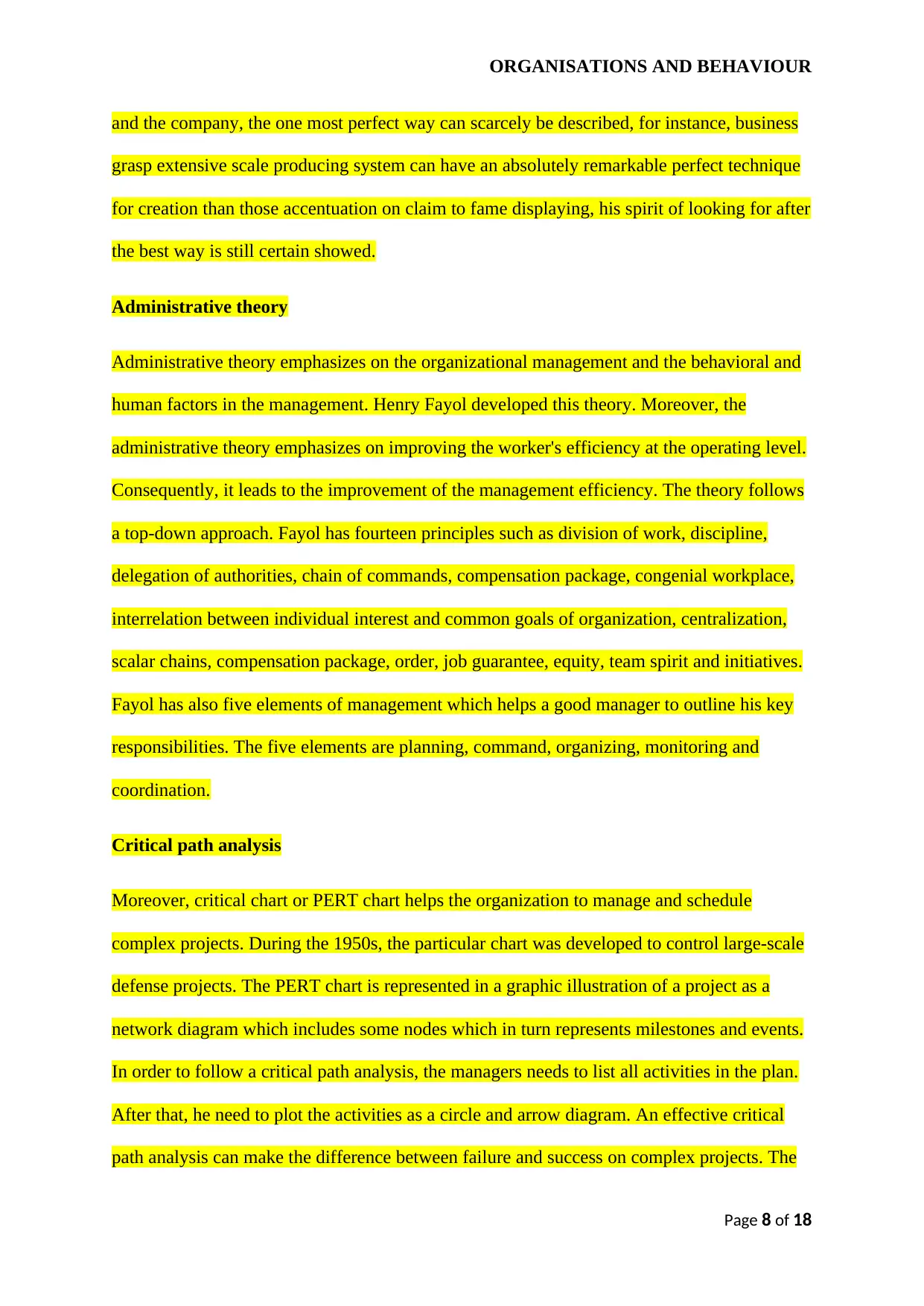
ORGANISATIONS AND BEHAVIOUR
and the company, the one most perfect way can scarcely be described, for instance, business
grasp extensive scale producing system can have an absolutely remarkable perfect technique
for creation than those accentuation on claim to fame displaying, his spirit of looking for after
the best way is still certain showed.
Administrative theory
Administrative theory emphasizes on the organizational management and the behavioral and
human factors in the management. Henry Fayol developed this theory. Moreover, the
administrative theory emphasizes on improving the worker's efficiency at the operating level.
Consequently, it leads to the improvement of the management efficiency. The theory follows
a top-down approach. Fayol has fourteen principles such as division of work, discipline,
delegation of authorities, chain of commands, compensation package, congenial workplace,
interrelation between individual interest and common goals of organization, centralization,
scalar chains, compensation package, order, job guarantee, equity, team spirit and initiatives.
Fayol has also five elements of management which helps a good manager to outline his key
responsibilities. The five elements are planning, command, organizing, monitoring and
coordination.
Critical path analysis
Moreover, critical chart or PERT chart helps the organization to manage and schedule
complex projects. During the 1950s, the particular chart was developed to control large-scale
defense projects. The PERT chart is represented in a graphic illustration of a project as a
network diagram which includes some nodes which in turn represents milestones and events.
In order to follow a critical path analysis, the managers needs to list all activities in the plan.
After that, he need to plot the activities as a circle and arrow diagram. An effective critical
path analysis can make the difference between failure and success on complex projects. The
Page 8 of 18
and the company, the one most perfect way can scarcely be described, for instance, business
grasp extensive scale producing system can have an absolutely remarkable perfect technique
for creation than those accentuation on claim to fame displaying, his spirit of looking for after
the best way is still certain showed.
Administrative theory
Administrative theory emphasizes on the organizational management and the behavioral and
human factors in the management. Henry Fayol developed this theory. Moreover, the
administrative theory emphasizes on improving the worker's efficiency at the operating level.
Consequently, it leads to the improvement of the management efficiency. The theory follows
a top-down approach. Fayol has fourteen principles such as division of work, discipline,
delegation of authorities, chain of commands, compensation package, congenial workplace,
interrelation between individual interest and common goals of organization, centralization,
scalar chains, compensation package, order, job guarantee, equity, team spirit and initiatives.
Fayol has also five elements of management which helps a good manager to outline his key
responsibilities. The five elements are planning, command, organizing, monitoring and
coordination.
Critical path analysis
Moreover, critical chart or PERT chart helps the organization to manage and schedule
complex projects. During the 1950s, the particular chart was developed to control large-scale
defense projects. The PERT chart is represented in a graphic illustration of a project as a
network diagram which includes some nodes which in turn represents milestones and events.
In order to follow a critical path analysis, the managers needs to list all activities in the plan.
After that, he need to plot the activities as a circle and arrow diagram. An effective critical
path analysis can make the difference between failure and success on complex projects. The
Page 8 of 18
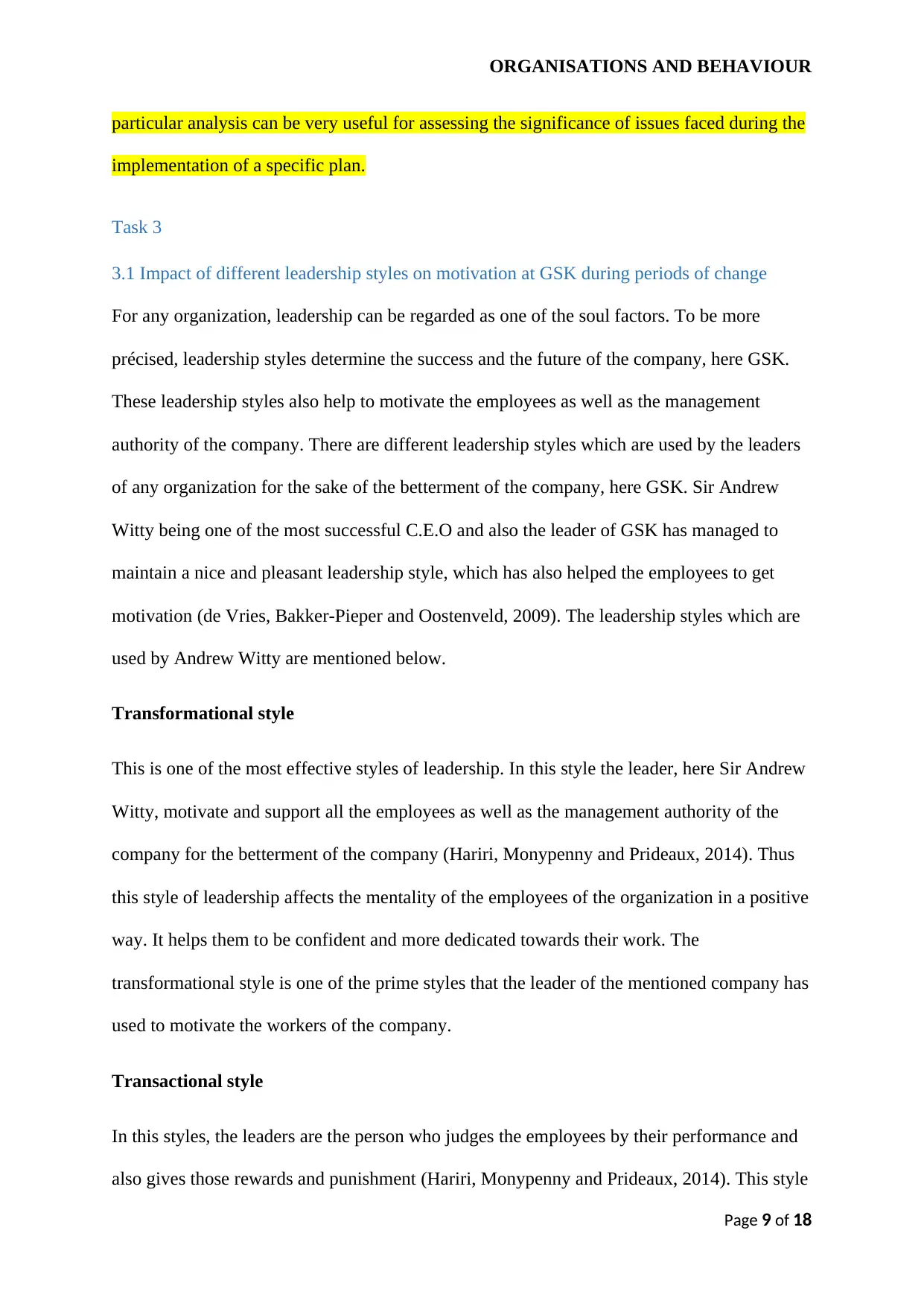
ORGANISATIONS AND BEHAVIOUR
particular analysis can be very useful for assessing the significance of issues faced during the
implementation of a specific plan.
Task 3
3.1 Impact of different leadership styles on motivation at GSK during periods of change
For any organization, leadership can be regarded as one of the soul factors. To be more
précised, leadership styles determine the success and the future of the company, here GSK.
These leadership styles also help to motivate the employees as well as the management
authority of the company. There are different leadership styles which are used by the leaders
of any organization for the sake of the betterment of the company, here GSK. Sir Andrew
Witty being one of the most successful C.E.O and also the leader of GSK has managed to
maintain a nice and pleasant leadership style, which has also helped the employees to get
motivation (de Vries, Bakker-Pieper and Oostenveld, 2009). The leadership styles which are
used by Andrew Witty are mentioned below.
Transformational style
This is one of the most effective styles of leadership. In this style the leader, here Sir Andrew
Witty, motivate and support all the employees as well as the management authority of the
company for the betterment of the company (Hariri, Monypenny and Prideaux, 2014). Thus
this style of leadership affects the mentality of the employees of the organization in a positive
way. It helps them to be confident and more dedicated towards their work. The
transformational style is one of the prime styles that the leader of the mentioned company has
used to motivate the workers of the company.
Transactional style
In this styles, the leaders are the person who judges the employees by their performance and
also gives those rewards and punishment (Hariri, Monypenny and Prideaux, 2014). This style
Page 9 of 18
particular analysis can be very useful for assessing the significance of issues faced during the
implementation of a specific plan.
Task 3
3.1 Impact of different leadership styles on motivation at GSK during periods of change
For any organization, leadership can be regarded as one of the soul factors. To be more
précised, leadership styles determine the success and the future of the company, here GSK.
These leadership styles also help to motivate the employees as well as the management
authority of the company. There are different leadership styles which are used by the leaders
of any organization for the sake of the betterment of the company, here GSK. Sir Andrew
Witty being one of the most successful C.E.O and also the leader of GSK has managed to
maintain a nice and pleasant leadership style, which has also helped the employees to get
motivation (de Vries, Bakker-Pieper and Oostenveld, 2009). The leadership styles which are
used by Andrew Witty are mentioned below.
Transformational style
This is one of the most effective styles of leadership. In this style the leader, here Sir Andrew
Witty, motivate and support all the employees as well as the management authority of the
company for the betterment of the company (Hariri, Monypenny and Prideaux, 2014). Thus
this style of leadership affects the mentality of the employees of the organization in a positive
way. It helps them to be confident and more dedicated towards their work. The
transformational style is one of the prime styles that the leader of the mentioned company has
used to motivate the workers of the company.
Transactional style
In this styles, the leaders are the person who judges the employees by their performance and
also gives those rewards and punishment (Hariri, Monypenny and Prideaux, 2014). This style
Page 9 of 18
⊘ This is a preview!⊘
Do you want full access?
Subscribe today to unlock all pages.

Trusted by 1+ million students worldwide
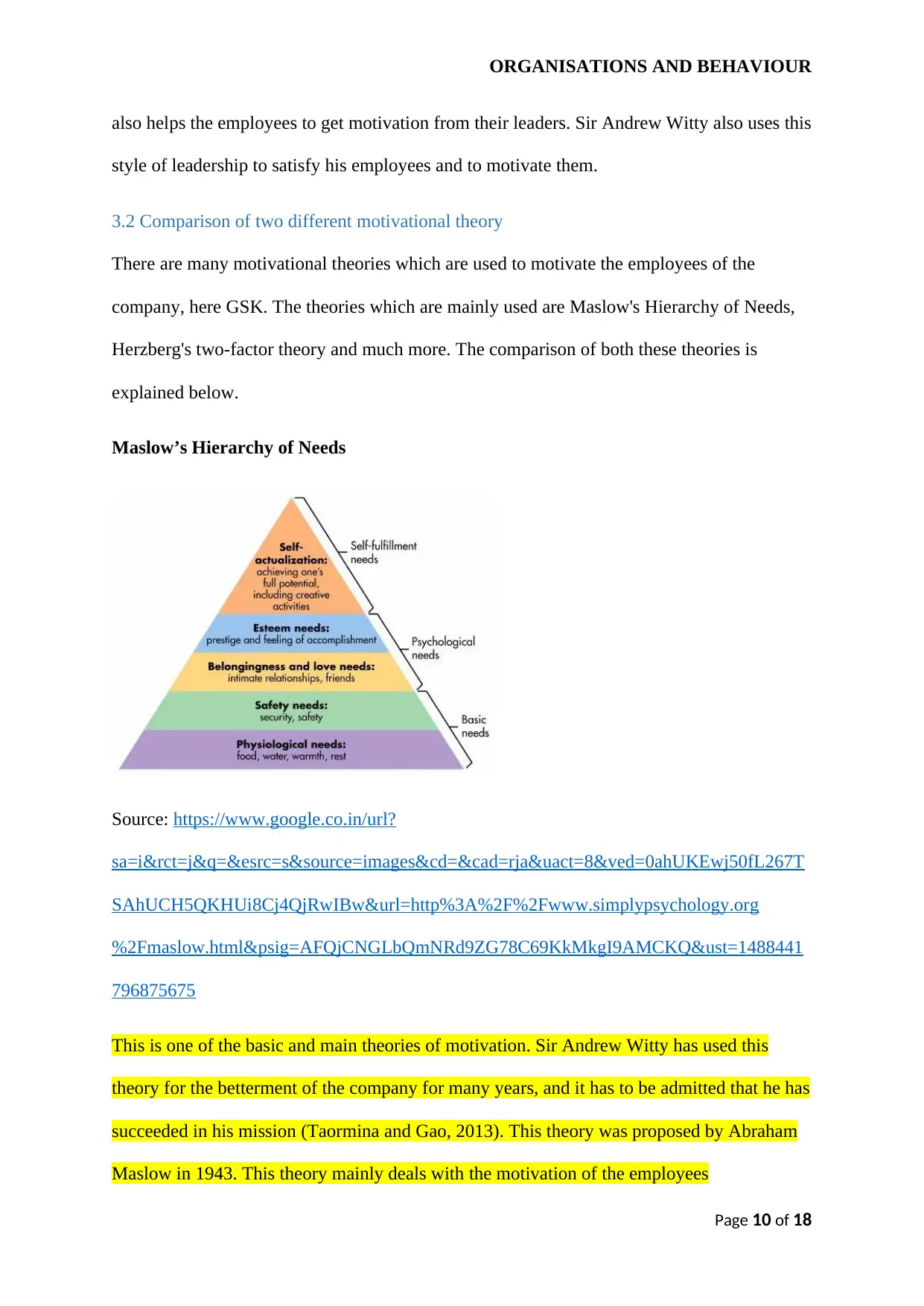
ORGANISATIONS AND BEHAVIOUR
also helps the employees to get motivation from their leaders. Sir Andrew Witty also uses this
style of leadership to satisfy his employees and to motivate them.
3.2 Comparison of two different motivational theory
There are many motivational theories which are used to motivate the employees of the
company, here GSK. The theories which are mainly used are Maslow's Hierarchy of Needs,
Herzberg's two-factor theory and much more. The comparison of both these theories is
explained below.
Maslow’s Hierarchy of Needs
Source: https://www.google.co.in/url?
sa=i&rct=j&q=&esrc=s&source=images&cd=&cad=rja&uact=8&ved=0ahUKEwj50fL267T
SAhUCH5QKHUi8Cj4QjRwIBw&url=http%3A%2F%2Fwww.simplypsychology.org
%2Fmaslow.html&psig=AFQjCNGLbQmNRd9ZG78C69KkMkgI9AMCKQ&ust=1488441
796875675
This is one of the basic and main theories of motivation. Sir Andrew Witty has used this
theory for the betterment of the company for many years, and it has to be admitted that he has
succeeded in his mission (Taormina and Gao, 2013). This theory was proposed by Abraham
Maslow in 1943. This theory mainly deals with the motivation of the employees
Page 10 of 18
also helps the employees to get motivation from their leaders. Sir Andrew Witty also uses this
style of leadership to satisfy his employees and to motivate them.
3.2 Comparison of two different motivational theory
There are many motivational theories which are used to motivate the employees of the
company, here GSK. The theories which are mainly used are Maslow's Hierarchy of Needs,
Herzberg's two-factor theory and much more. The comparison of both these theories is
explained below.
Maslow’s Hierarchy of Needs
Source: https://www.google.co.in/url?
sa=i&rct=j&q=&esrc=s&source=images&cd=&cad=rja&uact=8&ved=0ahUKEwj50fL267T
SAhUCH5QKHUi8Cj4QjRwIBw&url=http%3A%2F%2Fwww.simplypsychology.org
%2Fmaslow.html&psig=AFQjCNGLbQmNRd9ZG78C69KkMkgI9AMCKQ&ust=1488441
796875675
This is one of the basic and main theories of motivation. Sir Andrew Witty has used this
theory for the betterment of the company for many years, and it has to be admitted that he has
succeeded in his mission (Taormina and Gao, 2013). This theory was proposed by Abraham
Maslow in 1943. This theory mainly deals with the motivation of the employees
Page 10 of 18
Paraphrase This Document
Need a fresh take? Get an instant paraphrase of this document with our AI Paraphraser
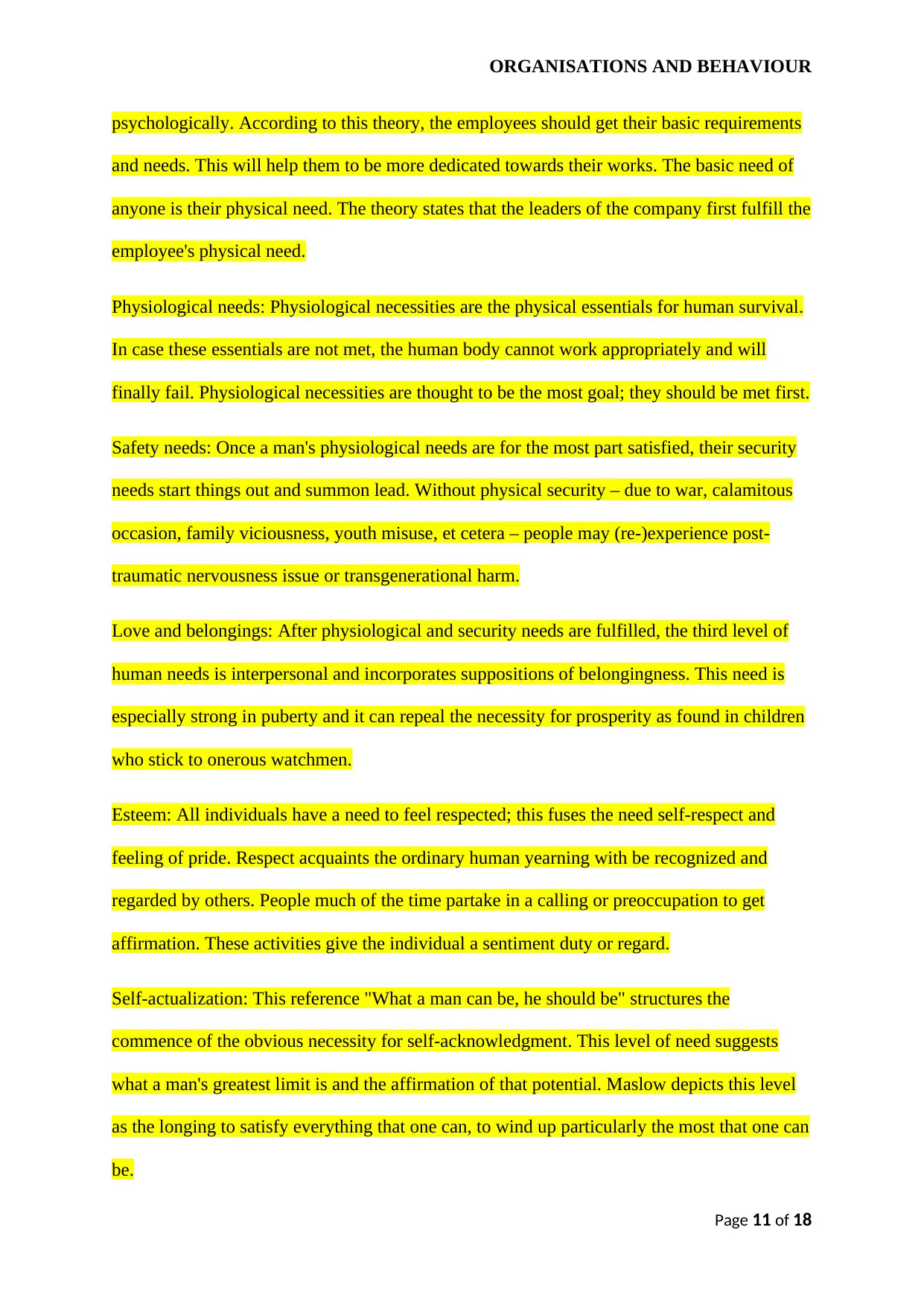
ORGANISATIONS AND BEHAVIOUR
psychologically. According to this theory, the employees should get their basic requirements
and needs. This will help them to be more dedicated towards their works. The basic need of
anyone is their physical need. The theory states that the leaders of the company first fulfill the
employee's physical need.
Physiological needs: Physiological necessities are the physical essentials for human survival.
In case these essentials are not met, the human body cannot work appropriately and will
finally fail. Physiological necessities are thought to be the most goal; they should be met first.
Safety needs: Once a man's physiological needs are for the most part satisfied, their security
needs start things out and summon lead. Without physical security – due to war, calamitous
occasion, family viciousness, youth misuse, et cetera – people may (re-)experience post-
traumatic nervousness issue or transgenerational harm.
Love and belongings: After physiological and security needs are fulfilled, the third level of
human needs is interpersonal and incorporates suppositions of belongingness. This need is
especially strong in puberty and it can repeal the necessity for prosperity as found in children
who stick to onerous watchmen.
Esteem: All individuals have a need to feel respected; this fuses the need self-respect and
feeling of pride. Respect acquaints the ordinary human yearning with be recognized and
regarded by others. People much of the time partake in a calling or preoccupation to get
affirmation. These activities give the individual a sentiment duty or regard.
Self-actualization: This reference "What a man can be, he should be" structures the
commence of the obvious necessity for self-acknowledgment. This level of need suggests
what a man's greatest limit is and the affirmation of that potential. Maslow depicts this level
as the longing to satisfy everything that one can, to wind up particularly the most that one can
be.
Page 11 of 18
psychologically. According to this theory, the employees should get their basic requirements
and needs. This will help them to be more dedicated towards their works. The basic need of
anyone is their physical need. The theory states that the leaders of the company first fulfill the
employee's physical need.
Physiological needs: Physiological necessities are the physical essentials for human survival.
In case these essentials are not met, the human body cannot work appropriately and will
finally fail. Physiological necessities are thought to be the most goal; they should be met first.
Safety needs: Once a man's physiological needs are for the most part satisfied, their security
needs start things out and summon lead. Without physical security – due to war, calamitous
occasion, family viciousness, youth misuse, et cetera – people may (re-)experience post-
traumatic nervousness issue or transgenerational harm.
Love and belongings: After physiological and security needs are fulfilled, the third level of
human needs is interpersonal and incorporates suppositions of belongingness. This need is
especially strong in puberty and it can repeal the necessity for prosperity as found in children
who stick to onerous watchmen.
Esteem: All individuals have a need to feel respected; this fuses the need self-respect and
feeling of pride. Respect acquaints the ordinary human yearning with be recognized and
regarded by others. People much of the time partake in a calling or preoccupation to get
affirmation. These activities give the individual a sentiment duty or regard.
Self-actualization: This reference "What a man can be, he should be" structures the
commence of the obvious necessity for self-acknowledgment. This level of need suggests
what a man's greatest limit is and the affirmation of that potential. Maslow depicts this level
as the longing to satisfy everything that one can, to wind up particularly the most that one can
be.
Page 11 of 18
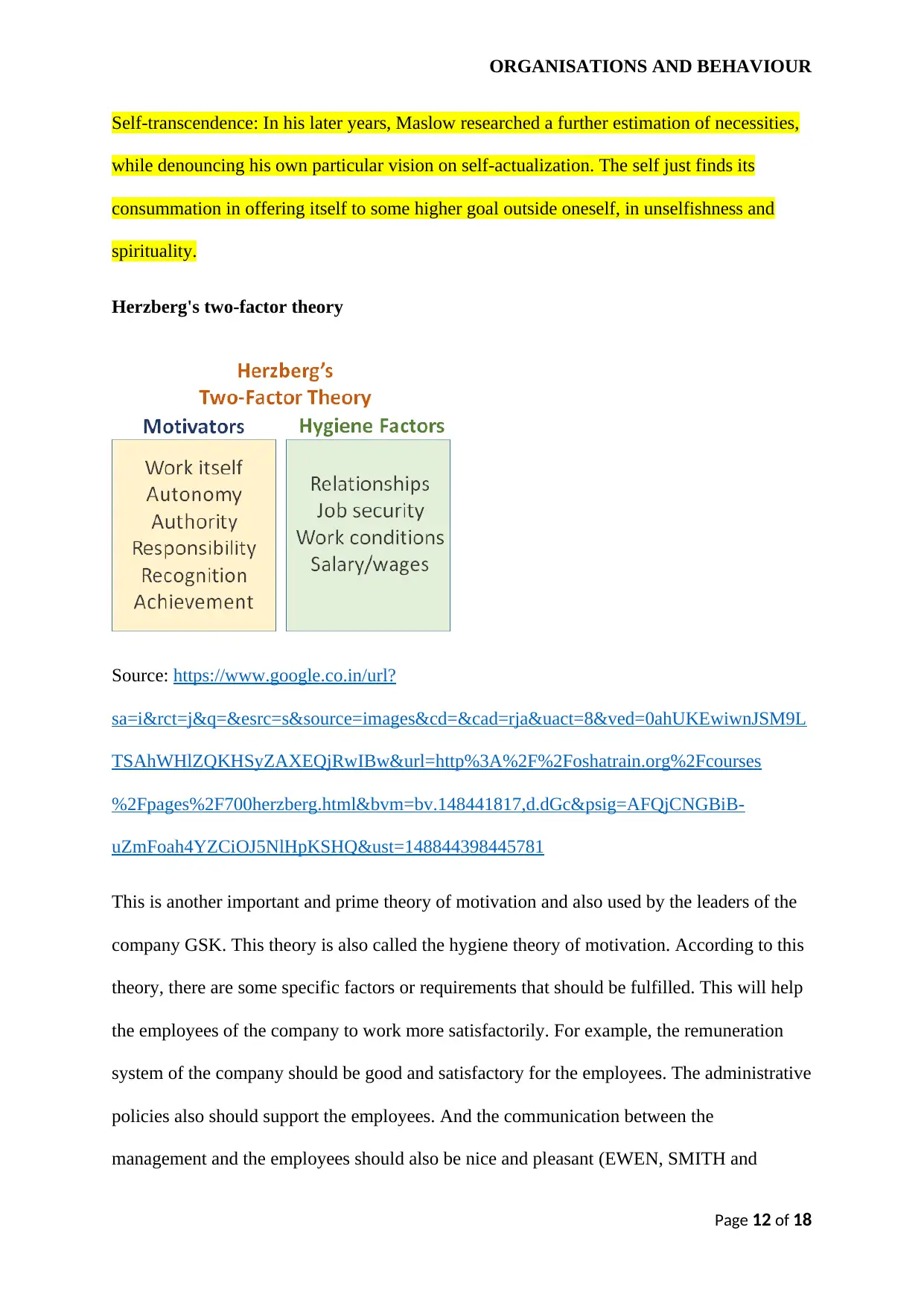
ORGANISATIONS AND BEHAVIOUR
Self-transcendence: In his later years, Maslow researched a further estimation of necessities,
while denouncing his own particular vision on self-actualization. The self just finds its
consummation in offering itself to some higher goal outside oneself, in unselfishness and
spirituality.
Herzberg's two-factor theory
Source: https://www.google.co.in/url?
sa=i&rct=j&q=&esrc=s&source=images&cd=&cad=rja&uact=8&ved=0ahUKEwiwnJSM9L
TSAhWHlZQKHSyZAXEQjRwIBw&url=http%3A%2F%2Foshatrain.org%2Fcourses
%2Fpages%2F700herzberg.html&bvm=bv.148441817,d.dGc&psig=AFQjCNGBiB-
uZmFoah4YZCiOJ5NlHpKSHQ&ust=148844398445781
This is another important and prime theory of motivation and also used by the leaders of the
company GSK. This theory is also called the hygiene theory of motivation. According to this
theory, there are some specific factors or requirements that should be fulfilled. This will help
the employees of the company to work more satisfactorily. For example, the remuneration
system of the company should be good and satisfactory for the employees. The administrative
policies also should support the employees. And the communication between the
management and the employees should also be nice and pleasant (EWEN, SMITH and
Page 12 of 18
Self-transcendence: In his later years, Maslow researched a further estimation of necessities,
while denouncing his own particular vision on self-actualization. The self just finds its
consummation in offering itself to some higher goal outside oneself, in unselfishness and
spirituality.
Herzberg's two-factor theory
Source: https://www.google.co.in/url?
sa=i&rct=j&q=&esrc=s&source=images&cd=&cad=rja&uact=8&ved=0ahUKEwiwnJSM9L
TSAhWHlZQKHSyZAXEQjRwIBw&url=http%3A%2F%2Foshatrain.org%2Fcourses
%2Fpages%2F700herzberg.html&bvm=bv.148441817,d.dGc&psig=AFQjCNGBiB-
uZmFoah4YZCiOJ5NlHpKSHQ&ust=148844398445781
This is another important and prime theory of motivation and also used by the leaders of the
company GSK. This theory is also called the hygiene theory of motivation. According to this
theory, there are some specific factors or requirements that should be fulfilled. This will help
the employees of the company to work more satisfactorily. For example, the remuneration
system of the company should be good and satisfactory for the employees. The administrative
policies also should support the employees. And the communication between the
management and the employees should also be nice and pleasant (EWEN, SMITH and
Page 12 of 18
⊘ This is a preview!⊘
Do you want full access?
Subscribe today to unlock all pages.

Trusted by 1+ million students worldwide
1 out of 18
Related Documents
Your All-in-One AI-Powered Toolkit for Academic Success.
+13062052269
info@desklib.com
Available 24*7 on WhatsApp / Email
![[object Object]](/_next/static/media/star-bottom.7253800d.svg)
Unlock your academic potential
Copyright © 2020–2025 A2Z Services. All Rights Reserved. Developed and managed by ZUCOL.





